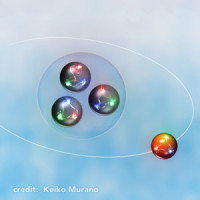RIKEN Research: Light nucleus predicted to be stable despite having two strange quarks

Adding an exotic particle known as a Xi hyperon to a helium nucleus with three nucleons could produce a nucleus that is temporarily stable, calculations by RIKEN nuclear physicists have predicted1. This result will help experimentalists search for the nucleus and provide insights into both nuclear physics and the structure of neutron stars.
Normal atomic nuclei consist of protons and neutrons, which are collectively known as nucleons. Each proton and neutron in turn is made up of three quarks. Quarks come in six types: up, down, strange, charm, bottom and top. But protons and neutrons consist only of up and down quarks.
Nuclear physicists have long been interested in hypernuclei—nuclei that contain one or more hyperons in which at least one of the three quarks is a strange quark. While only a handful of hypernuclei have been created at nuclear physics facilities, they provide a valuable new window into the mysteries of nuclei.
“Standard nuclei are defined by how many protons and neutrons they contain, and that’s it. They’re essentially two dimensional,” says Takumi Doi at the RIKEN Nishina Center for Accelerator-Based Science and the RIKEN Interdisciplinary Theoretical and Mathematical Sciences Program. “Hyperons offer us an extra dimension through the number of strange quarks—this enables us to gain deeper insight into a nucleus, such as the interactions that make a nucleus stable.”


